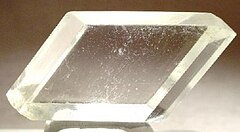Selenite (mineral)
| Selenite | |
|---|---|
 |
|
| General | |
| Category | Sulfate mineral |
|
Formula (repeating unit) |
CaSO4·2H2O |
| Crystal system | Monoclinic (2/m) Space Group: A2/a |
| Identification | |
| Formula mass | 172.17 |
| Color | Brown green, Brownish yellow, Greenish, Gray green, Gray white |
| Crystal habit | Earthy - Dull, clay-like texture with no visible crystalline affinities, (e.g. howlite). |
| Cleavage | [010] Perfect, [100] Distinct, [011] Distinct |
| Fracture | Fibrous - Thin, elongated fractures produced by crystal forms or intersecting cleavages (e.g. asbestos). |
| Mohs scale hardness | 2 |
| Luster | Pearly |
| Streak | white |
| Specific gravity | 2.9 |
| Optical properties | Biaxial (-) 2V=58 |
| Refractive index | nα=1.519-1.521, nβ=1.522-1.523, nγ=1.529-1.53 |
| Birefringence | δ =0.0090-0.0100 |
| Other characteristics | non-radioactive, non-magnetic, Fluorescent. |
| References | |
Selenite, satin spar, desert rose, and gypsum flower are four varieties of the mineral gypsum; all four varieties show obvious crystalline structure. The four "crystalline" varieties of gypsum are sometimes grouped together and called selenite.
All varieties of gypsum, including selenite and alabaster, are composed of calcium sulfate dihydrate (meaning that it has two molecules of water), with the chemical formula CaSO4·2H2O. Selenite contains no significant selenium; the similarity of names comes from both substances being named from the Ancient Greek word for the Moon.
The etymology of selenite is through Middle English selinete, from Latin selenites, from Greek selēnitēs (lithos), literally, moonstone or stone of the moon, from selēnē (Moon). The ancients had a belief that certain transparent crystals waxed and waned with the moon. From the 15th century, "selenite" has referred specifically to the variety of gypsum that occurs in transparent crystals or crystalline masses.
All varieties of gypsum are very soft minerals (hardness: 2 on Mohs Scale). This is the most important identifying characteristic of gypsum, as any variety of gypsum can be easily scratched with a fingernail. Also, because gypsum has natural thermal insulating properties, all varieties feel warm to the touch.
Though sometimes grouped together as "selenite", the four crystalline varieties have differences. General identifying descriptions of the related crystalline varieties are:
Varieties of gypsum known as "satin spar" and "alabaster" are used for a variety of ornamental purposes.. But also because of the long history of the commercial value and use of both gypsum and alabaster, the four crystalline varieties have been somewhat ignored, except as a curiosity or as rock collectibles(not commonly used).
Crystal habit refers to the shapes that crystals exhibit.
Selenite crystals commonly occur as tabular, reticular, and columnar crystals, often with no imperfections or inclusions, and thereby can appear water or glass-like. Many collectible selenite crystals have interesting inclusions such as, accompanying related minerals, interior druse, dendrites, and fossils. In some rare instances, water was encased as a fluid inclusion when the crystal formed (see Peñoles Mine reference in external links).
...
Wikipedia
